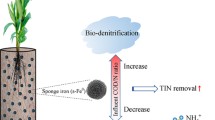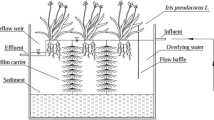Abstract
Floating treatment wetland (FTW) in restoration of low C/N ratio wastewater was deemed to a frequently used method. However, the nitrate removal performance in floating beds was limited due to insufficient organic carbon sources. Iron scraps as a potential electron donor was beneficial to the NO3--N reduction. To research the removal performance and mechanism of denitrification in FTW with iron scraps, FTW with Iris pseudacorus was built, and iron scraps were added as an electron donor to improve nitrogen removal efficiency. The batch experimental results demonstrated that the proper mass ratio of iron scraps to NO3--N was 500:1. With iron scraps, the NO3--N removal efficiency of FTW and control system increased significantly to 98.04% and 44.42% respectively in 2 weeks, while there was no obvious influence on the removal of NH4+-N. After adding iron scraps, the proportion of bacteria in the systems related to iron cycle and the relative abundance of nitrifying and denitrifying bacteria have increased obviously. By calculating the nitrogen balance, nitrogen reduction via plant uptake accounted for 8.79%, and the microbial denitrification was the main nitrogen removal pathway in FTW.
Graphical abstract






Similar content being viewed by others
Data availability
All data generated or analyzed during this study are included in this article and Supplementary materials.
References
Ai T, Zhan H, Zou L, Fu J, Fu Q, He Q, Ai H (2020) Potential applications of endogenous sulfide for enhanced denitrification of low C/N domestic wastewater in anodic mixotrophic denitrification microbial fuel cell: the mechanism of electrons transfer and microbial community. Sci Total Environ 722:137830
Ansola G, Arroyo P, de Miera LES (2014) Characterisation of the soil bacterial community structure and composition of natural and constructed wetlands. Sci Total Environ 473:63–71
APHA (2005) Standard methods for water and wastewater examination. American Public Health Association, Washington, D.C.
Bibby TS, Nield J, Barber J (2001) Iron deficiency induces the formation of an antenna ring around trimeric photosystem I in cyanobacteria. Nature 412:743–745
Biswas S, Bose P (2005) Zero-valent iron-assisted autotrophic denitrification. J Environ Eng 131:1212–1220
Chen Y, Wen Y, Tang Z, Huang J, Zhou Q, Vymazal J (2015) Effects of plant biomass on bacterial community structure in constructed wetlands used for tertiary wastewater treatment. Ecol Eng 84:38–45
Chen H, Zhao X, Cheng Y, Jiang M, Li X, Xue G (2018) Iron robustly stimulates simultaneous nitrification and denitrification under aerobic conditions. Environ Sci Technol 52:1404–1412
Chen D, Gu X, Zhu W, He S, Wu F, Huang J, Zhou W (2019) Denitrification-and anammox-dominant simultaneous nitrification, anammox and denitrification (SNAD) process in subsurface flow constructed wetlands. Bioresour Technol 271:298–305
Daims H, Lücker S, Wagner M (2016) A new perspective on microbes formerly known as nitrite-oxidizing. Bacteria Trends Microbiol 24:699–712
Deng S, Li D, Yang X, Xing W, Li J, Zhang Q (2016) Biological denitrification process based on the Fe(0)-carbon micro-electrolysis for simultaneous ammonia and nitrate removal from low organic carbon water under a microaerobic condition. Bioresour Technol 219:677–686
Di Capua F, Ahoranta SH, Papirio S, Lens PN, Esposito G (2016) Impacts of sulfur source and temperature on sulfur-driven denitrification by pure and mixed cultures of Thiobacillus. Process Biochem 51(10):1576–1584
Fabisch M, Beulig F, Akob DM, Küsel K (2013) Surprising abundance of Gallionella-related iron oxidizers in creek sediments at pH 4.4 or at high heavy metal concentrations. Front Microbiol 4:390
Gao L, Zhou W, Huang J, He S, Yan Y, Zhu W, Wu S, Zhang X (2017) Nitrogen removal by the enhanced floating treatment wetlands from the secondary effluent. Bioresour Technol 234:243–252
Gao L, Zhou W, Wu S, He S, Huang J, Zhang X (2018) Nitrogen removal by thiosulfate-driven denitrification and plant uptake in enhanced floating treatment wetland. Sci Total Environ 621:1550–1558
Hira D, Aiko N, Yabuki Y, Fujii T (2018) Impact of aerobic acclimation on the nitrification performance and microbial community of landfill leachate sludge. J Environ Manag 209:188–194
Hu H-Y, Goto N, Fujie K (2001) Effect of pH on the reduction of nitrite in water by metallic iron. Water Res 35:2789–2793
Isaka K, Kimura Y, Osaka T, Tsuneda S (2012) High-rate denitrification using polyethylene glycol gel carriers entrapping heterotrophic denitrifying bacteria. Water Res 46:4941–4948
Keizer-Vlek HE, Verdonschot PF, Verdonschot RC, Dekkers D (2014) The contribution of plant uptake to nutrient removal by floating treatment wetlands. Ecol Eng 73:684–690
Kielemoes J, De Boever P, Verstraete W (2000) Influence of denitrification on the corrosion of iron and stainless steel powder. Environ Sci Technol 34:663–671
Kiskira K, Papirio S, van Hullebusch ED, Esposito G (2017) Influence of pH, EDTA/Fe (II) ratio, and microbial culture on Fe (II)-mediated autotrophic denitrification. Environ Sci Pollut Res 24:21323–21333
Liu R, Zhao Y, Doherty L, Hu Y, Hao X (2015) A review of incorporation of constructed wetland with other treatment processes. Chem Eng J 279:220–230
Liu X, Huang M, Bao S, Tang W, Fang T (2020) Nitrate removal from low carbon-to-nitrogen ratio wastewater by combining iron-based chemical reduction and autotrophic denitrification. Bioresour Technol 301:122731
Ma B, Yang L, Wang Q, Yuan Z, Wang Y, Peng Y (2017) Inactivation and adaptation of ammonia-oxidizing bacteria and nitrite-oxidizing bacteria when exposed to free nitrous acid. Bioresour Technol 245:1266–1270
Ma Y, Dai W, Zheng P, Zheng X, He S, Zhao M (2020) Iron scraps enhance simultaneous nitrogen and phosphorus removal in subsurface flow constructed wetlands. J Hazard Mater 395:122612
Meng D, Li J, Liu T, Liu Y, Yan M, Hu J, Li X, Liu X, Liang Y, Liu H, Yin H (2019) Effects of redox potential on soil cadmium solubility: insight into microbial community. J Environ Sci 75:224–232
Nguyen VK, Hong S, Park Y, Jo K, Lee T (2015) Autotrophic denitrification performance and bacterial community at biocathodes of bioelectrochemical systems with either abiotic or biotic anodes. J Biosci Bioeng 119:180–187
Picardal F (2012) Abiotic and microbial interactions during anaerobic transformations of Fe (II) and NOx. Front Microbiol 3:112
Reinhardt M, Müller B, Gächter R, Wehrli B (2006) Nitrogen removal in a small constructed wetland: an isotope mass balance approach. Environ Sci Technol 40(10):3313–3319
Ryu A, Jeong S-W, Jang A, Choi H (2011) Reduction of highly concentrated nitrate using nanoscale zero-valent iron: effects of aggregation and catalyst on reactivity. Appl Catal B Environ 105:128–135
Si Z et al (2020) Untangling the nitrate removal pathways for a constructed wetland-sponge iron coupled system and the impacts of sponge iron on a wetland ecosystem. J Hazard Mater 393:122407
Simon J, Klotz MG (2013) Diversity and evolution of bioenergetic systems involved in microbial nitrogen compound transformations. Biochim Biophys Acta 1827:114–135
Sohn K, Kang SW, Ahn S, Woo M, Yang S-K (2006) Fe (0) nanoparticles for nitrate reduction: stability, reactivity, and transformation. Environ Sci Technol 40:5514–5519
Straub KL, Benz M, Schink B, Widdel F (1996) Anaerobic, nitrate-dependent microbial oxidation of ferrous iron. Appl Environ Microbiol 62:1458–1460
Sun S, Gao L, He S, Huang J, Zhou W (2019a) Nitrogen removal in response to plants harvesting in two kinds of enhanced hydroponic root mats treating secondary effluent. Sci Total Environ 670:200–209
Sun S, Liu J, Zhang M, He S (2019b) Simultaneous improving nitrogen removal and decreasing greenhouse gas emission with biofilm carriers addition in ecological floating bed. Bioresour Technol 292:121944
Suzuki T, Moribe M, Oyama Y, Niinae M (2012) Mechanism of nitrate reduction by zero-valent iron: equilibrium and kinetics studies. Chem Eng J 183:271–277
Tanner CC, Clayton JS, Upsdell MP (1995) Effect of loading rate and planting on treatment of dairy farm wastewaters in constructed wetlands—II. Removal of nitrogen and phosphorus. Water Res 29:27–34
Till BA, Weathers LJ, Alvarez PJ (1998) Fe (0)-supported autotrophic denitrification. Environ Sci Technol 32:634–639
Wang Z, Wang H, Ma L (2012) Iron shavings supported biological denitrification in sequencing batch reactor. Desalin Water Treat 49:95–105
Wang H, Hu C, Zhang L, Li X, Zhang Y, Yang M (2014a) Effects of microbial redox cycling of iron on cast iron pipe corrosion in drinking water distribution systems. Water Res 65:362–370
Wang R, Zheng P, Xing YJ, Zhang M, Ghulam A, Zhao ZQ, Li W, Wang L (2014b) Anaerobic ferrous oxidation by heterotrophic denitrifying enriched culture. J Ind Microbiol Biotechnol 41(5):803–809
Wang K, Jia R, Li L, Jiang R, Qu D (2020) Community structure of Anaeromyxobacter in Fe (III) reducing enriched cultures of paddy soils. J Soils Sediments 20:1621–1631
Xu Y et al (2017) Application of zero valent iron coupling with biological process for wastewater treatment: a review Reviews in Environ Sci. Biotechnol 16:667–693
Yang GC, Lee H-L (2005) Chemical reduction of nitrate by nanosized iron: kinetics and pathways. Water Res 39:884–894
Zhang W, Lei Q, Li Z, Han H (2016) Temporal variation of nitrogen balance within constructed wetlands treating slightly polluted water using a stable nitrogen isotope experiment. Environ Sci Pollut Res 23:2677–2683
Zhang Y et al (2017) Zero-valent iron-facilitated reduction of nitrate: chemical kinetics and reaction pathways. Sci Total Environ 598:1140–1150
Zhang Y, Ji G, Wang C, Zhang X, Xu M (2019a) Importance of denitrification driven by the relative abundances of microbial communities in coastal wetlands. Environ Pollut 244:47–54
Zhang Y, Liu X, Fu C, Li X, Yan B, Shi T (2019b) Effect of Fe2+ addition on chemical oxygen demand and nitrogen removal in horizontal subsurface flow constructed wetlands. Chemosphere 220:259–265
Zhao Y et al (2020) Effects of nZVI dosing on the improvement in the contaminant removal performance of constructed wetlands under the dye stress. Sci Total Environ 703:134789
Zheng X, Jin M, Zhou X, Chen W, Lu D, Zhang Y, Shao X (2019) Enhanced removal mechanism of iron carbon micro-electrolysis constructed wetland on C, N, and P in salty permitted effluent of wastewater treatment plant. Sci Total Environ 649:21–30
Zhou G-W et al (2016a) Electron shuttles enhance anaerobic ammonium oxidation coupled to iron (III) reduction. Environ Sci Technol 50:9298–9307
Zhou H, Li X, Chu Z, Zhang J (2016b) Effect of temperature downshifts on a bench-scale hybrid A/O system: process performance and microbial community dynamics. Chemosphere 153:500–507
Zhou J, Wang H, Yang K, Ji B, Chen D, Zhang H, Sun Y, Tian J (2016c) Autotrophic denitrification by nitrate-dependent Fe (II) oxidation in a continuous up-flow biofilter. Bioprocess Biosyst Eng 39:277–284
Zhou X, Liang C, Jia L, Feng L, Wang R, Wu H (2018) An innovative biochar-amended substrate vertical flow constructed wetland for low C/N wastewater treatment: impact of influent strengths. Bioresour Technol 247:844–850
Zhu I, Getting T (2012) A review of nitrate reduction using inorganic materials. Environ Technol Rev 1:46–58
Funding
This work is financially supported by the National Natural Science Foundation of China (No. 51678356), the National Key R&D Program of China (2017YFC0506003), and the Program for Chinese National Key Projects of Water Pollution Control and Reclamation (2017ZX07205003).
Author information
Authors and Affiliations
Contributions
All authors contributed to the study conception and design. Material preparation, data collection, and analysis were performed by Si Qin and Xiaoyi Zhang. The first draft of the manuscript was written by Si Qin, and all authors commented on previous versions of the manuscript. All authors read and approved the final manuscript.
Corresponding author
Ethics declarations
Competing interests
The authors declare that they have no known competing interests.
Ethical approval and consent to participate
This manuscript does not report on or involve the use of any animal or human data or tissue, so it is not applicable in this section.
Consent to publish
This manuscript does not contain data from any individual person, so it is not applicable in this section.
Additional information
Responsible Editor: Alexandros Stefanakis
Publisher’s note
Springer Nature remains neutral with regard to jurisdictional claims in published maps and institutional affiliations.
Supplementary Information
ESM 1
(DOCX 2938 kb)
Rights and permissions
About this article
Cite this article
Qin, S., Zhang, X., He, S. et al. Improvement of nitrogen removal with iron scraps in floating treatment wetlands. Environ Sci Pollut Res 28, 17878–17890 (2021). https://doi.org/10.1007/s11356-020-12177-x
Received:
Accepted:
Published:
Issue Date:
DOI: https://doi.org/10.1007/s11356-020-12177-x




